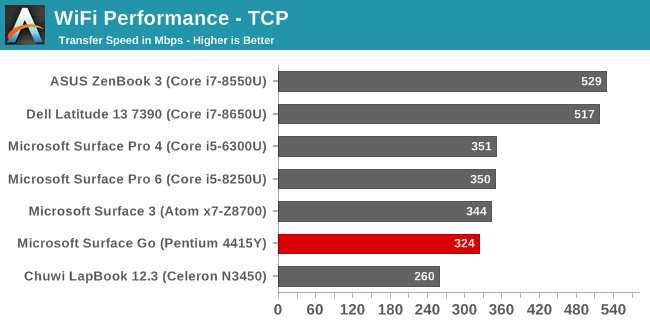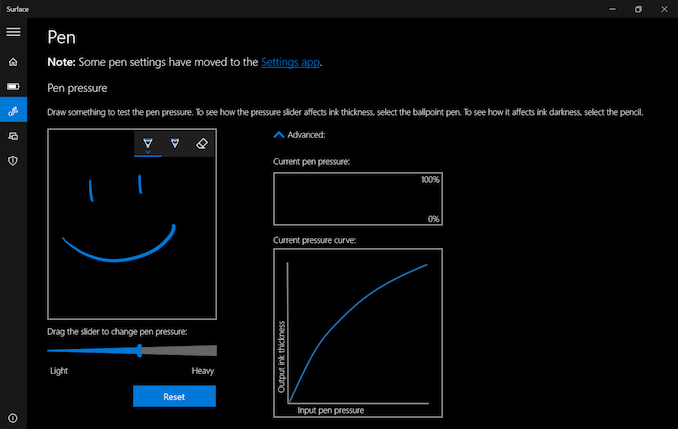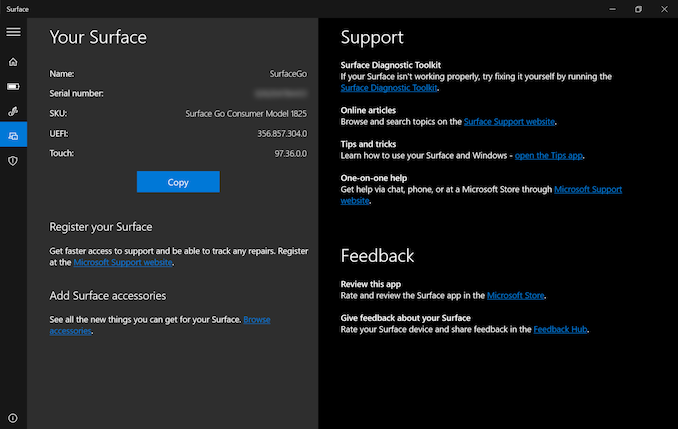The Microsoft Surface Go LTE Review: Unmatched Mobility
by Brett Howse on January 17, 2019 8:00 AM ESTWireless
Microsoft has relied on the Marvell AVASTAR wireless card for pretty much the entirety of their Surface lineup, so it was a bit surprising to see the Surface Go LTE come with a Qualcomm wireless solution in the QCA6174A product. This is a 2x2:2 MU-MIMO 802.11ac chip, with integrated Bluetooth 4.2. Likely the Qualcomm Wi-Fi is being used because Microsoft has also incorporated the Qualcomm Snapdragon X16 LTE modem in this product.

If the Surface lineup had a particular fault, it would be on the wireless performance, and despite the Surface Go offering a different Wi-Fi solution than the typical Marvell we see in Surface devices, the Surface Go still has the same mediocre wireless performance as the rest of the lineup. It is really something the company needs to address.
As far as the cellular, we won’t do bandwidth testing on this for the same reason we don’t do it on phones. The disparity in cellular connection speeds and supported standards is just too varied to provide an accurate result.
The addition to cellular in this device is pretty interesting though, and really opens it up to a much wider audience. Microsoft is clearly targeting business with the Surface Go LTE, although there’s definitely going to be consumer interest as well in having a device that is always connected. Not only will remote workers have a more reliable connection to the corporate network, but it will make it easier for IT to manage as well. It’s nice to see Microsoft pushing the Always Connected PC with their own products. For those that need more performance, the Surface Pro can be had with LTE, but for those that need mobility, Microsoft now offers a product in that category as well, since it’s been a few years since the Surface 3 LTE was made available.
Audio
The Surface Go continues with the design tricks of the Pro by hiding the speaker grilles in the black part of the display bezel. This makes them almost hidden, but provides the benefit of firing the drivers forwards, and providing good stereo separation.
The speakers in the Surface Go sound like a typical small PC though, with not much low end, but these ones are even quieter than most devices, averaging around 71 dB(A) measured an inch over the trackpad.
Thermals
If only all other devices were able to run as cool and quiet as a Surface Go, but alas, they are after performance. With just a 6-Watt TDP, and a 4.8-Watt SDP, the Intel Pentium Gold 4415Y can be easily cooled in a fanless design, so despite trying to see if the meager 1.6 GHz frequency would droop over time, it does not, and the Surface Go never gets very warm. This is the dream. We just need to tie some performance to it.
Software
The Surface Go comes with Windows 10 Home in S Mode, although businesses can also purchase it with Pro if they don’t have an Enterprise agreement. The S Mode is something Microsoft has been hoping would take off for some time, but if you do need to install apps that are not in the store, you can turn it off, although it must be noted that is a one-way switch. To go back to S Mode you would have to recover the device.
As with all Surface models, there’s a clean image to work with. The only real addition is a couple of apps, such as the Surface App where you can configure the pen, check the battery life of Microsoft accessories, or go for support. Most Surface devices tend to ship with a few other additions like Sketchable for use with the pen, and a couple of others, but nothing that can’t be removed with a couple of clicks.
Overall, it’s a clean image, and it needs to be since the base model ships with just 64 GB of storage.













79 Comments
View All Comments
thewishy - Thursday, January 17, 2019 - link
I've had a non-lte 8/128gb since November. I have a work Dell XPS 15, which is hugely powerful but has shockingly bad battery life and is utterly unsuited to use on a plane - so I have another machine to do heavy lifting.This machine gets used on work trips where I don't need much more than an RDP client to a lab, work, excel and OWA, and I want something to entertain me on long flights and evenings if I feel like.
It works brilliantly on the tray table in economy, the battery life might be "Poor", but with a 99wh USB-PD power pack the endurance of 16-24hrs. Given the cost and ease with which the life can be extended, 6hrs of browsing / word and 8-9 hours of movies without the power bank is reasonable IMHO. I wouldn't want to make it heavier for the sake of enhanced endurance. USB-PD charger allows me to charge phone, laptop and power bank with a single charger.
Performance is... slow. It's very noticeably less snappy than anything else I use, but doesn't crawl to a halt under load (For example, no problems with it swapping out). Under light use it's fine, and it works fine for light games.
Screen is sharp, a mouse transforms usability for office use. Keyboard is ok after a short adjustment period, but the trackpad can get in the way occasionally.
Bezel is a little large, but does make it easy to hand hold.
Lack of USB-A is a bit of a pain if you have a Yubikey, and a second USB-C would be lovely if you're using that for charging.
As my only machine it would drive me nuts, but for a specific use case it's been perfect.
TheinsanegamerN - Saturday, January 19, 2019 - link
The interior design of the Go is pathetic for battery packaging. You wouldnt have to make it thicker to fit more battery in there.Trefugl - Thursday, January 17, 2019 - link
Any idea how the CPU performance compares to the original Surface Pro (16:9 one)? I have one of those that I still use for travel, but it's definitely showing its age and the pen input isn't nearly as good as modern surface tablets, and the screens are nearly as nice either... Ideally I'm hoping that I could do some light editing of raw photos in lightroom while on the go, even if it's mildly painful... still better than trying to do it on my phone or carrying around something much bigger.Brett Howse - Thursday, January 17, 2019 - link
Hi Trefugl. I'll reference you to our Online Bench which was also linked in the article:https://www.anandtech.com/bench/product/1207?vs=23...
HStewart - Saturday, January 19, 2019 - link
I also have original Surface Pro and rarely use it - even though it performance is around i7 Y CPU.A good link to compare cpus is the following
https://cpu.userbenchmark.com/Compare/Intel-Pentiu...
It going to be really interesting to see Lakefield - it will like beat the Surface Pro 1 cpu in performance and have extreme battery life - this will be perfect for LTE companion
HStewart - Saturday, January 19, 2019 - link
Computer performance changes over time - I did use my Surface Pro 1 for photoshop and even Lightwave - but new CPU's today make a big difference.eastcoast_pete - Thursday, January 17, 2019 - link
Interesting device, somewhat overpriced. I really wish MS would go further on the mobility aspect and provide a significantly (50% bigger) larger battery. Even with 100 g more weight, it would still be light enough to carry around. Always connected shouldn't mean being plugged into an outlet after just a few hours.tmanini - Thursday, January 17, 2019 - link
"Microsoft also color calibrates all of its displays"I didn't find a handy reference article for this, so I can't confirm the statement or what exactly is done. But even if they do 'something' before it is boxed up, that calibration will drift in short order and essentially become useless. (if you plan to rely on it)
melgross - Thursday, January 17, 2019 - link
That’s not true. It used to be true in the days of the crt, but not now. Apple also calibrates all of its displays, including those in the iMac, and it’s pretty stable. That doesn’t mean that several years later it’s still perfect, but it’s pretty close, even then.The thing about these though, is that they’re just sRGB, which isn’t saying much these days.
anactoraaron - Thursday, January 17, 2019 - link
Exactly this. What exactly is the point of having a calibrated accurate display for maybe 1 month? Panels drift the most in the first year.The other thing that happens not just here at AT is these notebooks and tablets being touted as 'for image and video professionals' just because the display is accurate out of the box. This needs to stop.
Any system that lacks a display osd/hardware rgb channel/brightness/contrast adjustment isn't suited for any professional. Software can only do so much (making adjustments through Intel graphics software is awful) and for folks that absolutely need color accuracy (longer than 1 month out of the box) need the ability to adjust color channels, brightness, and contrast at the hardware level. I had a surface pro, and over time software couldn't properly calibrate it anymore. Sold it recently and went back to desktop, mobility be damned.